
Payson is a city in Utah County, Utah, United States. It is part of the Provo–Orem Metropolitan Statistical Area. The population was 18,294 at the 2010 census.

The Church Educational System (CES) of The Church of Jesus Christ of Latter-day Saints consists of several institutions that provide religious and secular education for both Latter-day Saint and non–Latter-day Saint elementary, secondary, and post-secondary students and adult learners. Approximately 700,000 individuals were enrolled in CES programs in 143 countries in 2011. CES courses of study are separate and distinct from religious instruction provided through wards. Paul V. Johnson, a General Authority Seventy, has been the CES Commissioner since August 1, 2019.

Karl Gottfried Maeser was a prominent Utah educator and a member of The Church of Jesus Christ of Latter-day Saints. He served 16 years as principal of Brigham Young Academy. Although he was not the first principal of the Academy, he is considered its founder. The Academy later became Brigham Young University (BYU) in 1903.
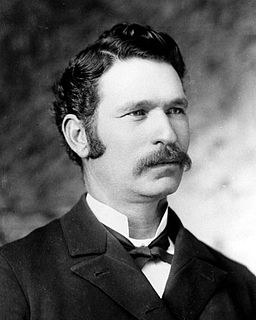
Benjamin Cluff Jr. was the first President of Brigham Young University, and the school's third principal. Under his administration, the student body and faculty more than doubled in size, and the school went from an academy to a university, and was officially incorporated by The Church of Jesus Christ of Latter-day Saints. Cluff changed class periods from half an hour to a full hour, adopted the official colors of the university, started summer school and the Alumni Association, encouraged the university's first student newspaper, provided the first student loans, and developed an intercollegiate sports system.
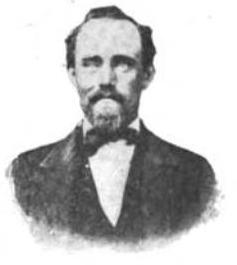
Warren Newton Dusenberry was the founding principal of Brigham Young Academy in 1876. Before becoming principal of Brigham Young Academy, Dusenberry was the founder of three other schools in Provo, Utah. Dusenberry was only a temporary principal and was succeeded by Karl G. Maeser. He also served as County Judge of Utah County and mayor of Provo.
Jacob Spori was the first principal of the Bannock Stake Academy, an institution that would eventually become Brigham Young University–Idaho.

Amy Cassandra Brown Lyman was the eighth general president of the Relief Society of The Church of Jesus Christ of Latter-day Saints from 1940 to 1945. Lyman also served a term as a member of the 14th Utah State Legislature from 1923 to 1924.
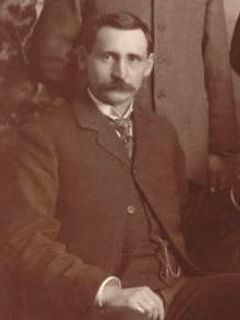
Joseph Marion ("Jay") Tanner was an American educator and a leader in The Church of Jesus Christ of Latter-day Saints. He has been described as "one of the most gifted teachers and writers in the [LDS] Church in the late nineteenth and early twentieth centuries".
Sidney Branton Sperry was one of three scholars who were members of The Church of Jesus Christ of Latter-day Saints who began the scholarly and systematic study of the Book of Mormon in the mid-20th century — the other two being John L. Sorenson and Hugh W. Nibley. Sperry was also a leading Latter-day Saint scholar of the Bible.
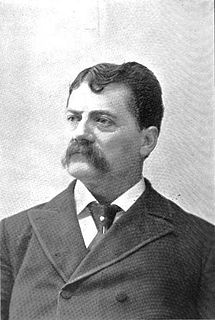
Milton Henry Hardy was an American educator and was the founder of and a member of the inaugural general superintendency of the Young Men's Mutual Improvement Association (YMMIA) of The Church of Jesus Christ of Latter-day Saints. From 1876 to 1880, Hardy was the first assistant to Junius F. Wells, the first president of the YMMIA.

The Provo City Library is a public library serving residents of Provo in the U.S. state of Utah. It occupies the building of the former Brigham Young Academy, which was built in 1892. In 1976, the building was added to the National Register of Historic Places. After a remodeling process, it was rededicated as the Provo City Library on September 8, 2001.

Harvey H. Cluff (1836–1916) was a business, civic and educational leader in late-19th-century Provo, Utah.
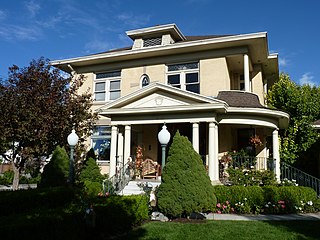
The Thomas N. Taylor House is a historic house located at 342 North 500 West in Provo, Utah. It is listed on the National Register of Historic Places.
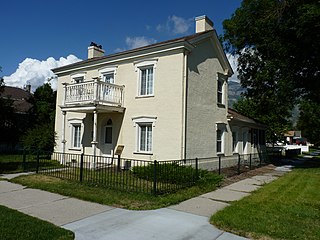
The Clark–Taylor House is a historic building located in Provo, Utah, United States. It is listed on the National Register of Historic Places. It has also been known as the T. N. Taylor Home. One of the oldest pioneer buildings in the state, the Clark–Taylor House was built around 1854. Thomas N. Taylor, a Provo Mayor, LDS bishop, and stake president, along with being a chairman of the board of trustees of BYU, lived in this home. The Clark–Taylor House was designated to the Provo City Historic Landmarks Registry on March 7, 1996.
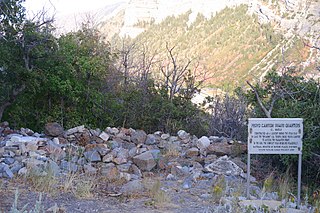
The Provo Canyon Guard Quarters is a historic building located in Provo, Utah. It is listed on the National Register of Historic Places.

The Provo Downtown Historic District is a 25-acre (10 ha) historic area located in Provo, Utah, United States. It is listed on the National Register of Historic Places.
Richard Charles Watkins, an immigrant from Bristol, England, was an American architect throughout the intermountain west in the late 19th and early 20th centuries. In his early career he interned with Richard K.A. Kletting in Salt Lake City. In 1890 he came to Provo, Utah as a construction supervisor, and opened his own firm in 1892. When he left nearly 20 years later he had become the most prominent architect south of Salt Lake City, Utah. His works include designing over 240 schools in the intermountain west of the United States including. He served as the architect for Utah State Schools between 1912 and 1920. He also designed businesses, courthouses, eight Carnegie libraries, churches and homes. A number of his buildings survive and are listed on the U.S. National Register of Historic Places.
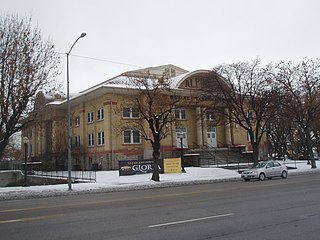
The Alpine Stake Tabernacle or Alpine Tabernacle, located at 110 East Main Street (US‑89) in American Fork, Utah, United States, functions as a meeting place for large gatherings of members of The Church of Jesus Christ of Latter-day Saints in northern Utah County for worship services. The building is part of the American Fork Historic District listed on the National Register of Historic Places.

Amanda Inez Knight Allen was a Mormon missionary and a Utah politician. In 1898, she became one of the first two single women to be missionaries for The Church of Jesus Christ of Latter-day Saints.

Merry May Booth Talmage was a member of The Church of Jesus Christ of Latter-day Saints and was the wife of James E. Talmage, a member of the Quorum of the Twelve Apostles. She oversaw the Relief Society in Europe from 1924 to 1927 when her husband was the president of the European Mission of the church.



















